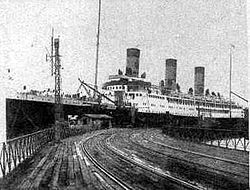Gallia (ship, 1913-1916)
|
Photo of Gallia in the newspaper Le Miroir , No. 152, page 16, October 22, 1916
|
||||||||||||||||||||
|
||||||||||||||||||||
|
||||||||||||||||||||
|
||||||||||||||||||||
|
||||||||||||||||||||
The Gallia was a passenger steamer put into service in 1913 by the French shipping company Compagnie de Navigation Sud-Atlantique , which served as a troop transport for the French Navy in World War I from May 16, 1916 , and on October 4, 1916 with a high loss of life near Sardinia was sunk by the German submarine U 35 .
The ship
In 1912 a new, large passenger ship was laid down at the Forges et Chantiers de la Méditerranée shipyard in La Seyne-sur-Mer . The 14,966 gross registered tons (GRT) Gallia was built for the French shipping company Compagnie de Navigation Sud-Atlantique, founded in 1910 and based in Bordeaux , in order to be able to keep up with other ships of the competition, mainly the Compagnie Générale Transatlantique .
On March 26, 1913, the steel- made ocean liner, 174.7 meters long and 19.1 meters wide, was launched. It was powered by two triple-expanding Parsons turbines that developed 26,000 hp and allowed a maximum cruising speed of 20.85 knots. The average cruising speed was 18 knots. The Gallia had a sister ship , the Lutetia (14,783 GRT). The two ships were the largest ocean liner of their shipping company until then. They were built for passenger and postal service from France to Brazil and Argentina .
On November 29, 1913, the Gallia ran from Bordeaux on her maiden voyage to Río de la Plata in Argentina. Shortly before that, she had passed her test drive from Bordeaux via Corsica and the Balearic Islands back to Bordeaux. Her time as a passenger steamer was very short. On May 16, 1916, it was requisitioned by the French Navy and then converted into an armed auxiliary cruiser to transport French soldiers from the Mediterranean to the Orient .
Sinking
On October 3, 1916, the Gallia in Toulon under the command of the 43-year-old Lieutenant Eugène Charles Kerboul without the accompanying ship Guichen (a protected cruiser ) intended for this purpose for another troop voyage to Thessaloniki in Greece . There were 2,350 people on board, including 1,650 French soldiers, 350 Serbian soldiers and 350 crew members.
On October 4, 1916 at around 5:30 p.m. Gallia , steaming eastwards, off the southeastern tip of the Mediterranean island of Sardinia, was sighted by the German submarine U 35 under the command of Lieutenant Lothar von Arnauld de la Perière . De la Perière attacked from a distance of 820 meters and estimated his chances to hit the Gallia, which was zigzagging at an estimated speed of 18 knots . His torpedo proved to be a direct hit and sank the Gallia 35 nautical miles southwest of the island of San Pietro off Sardinia . The force of the detonation was so strong that it destroyed the radio system so that no emergency call could be made.
There was great panic on board during the sinking. Dozens of people jumped overboard and many lifeboats were launched in too much rush. Of the 2,350 people on board, around 600 were killed; the exact number could never be determined due to missing lists. The vessel dropped to the position of 38 ° 16 '12 " N , 7 ° 18' 0" O . The survivors were picked up the following day by lifeboats and rafts on the French cruiser Châteaurenault .
Of the over 200 ships that U 35 sank during its service from 1915 to 1918, the Gallia was the largest. It was also among the 20 largest ships sunk by German submarines during World War I.

